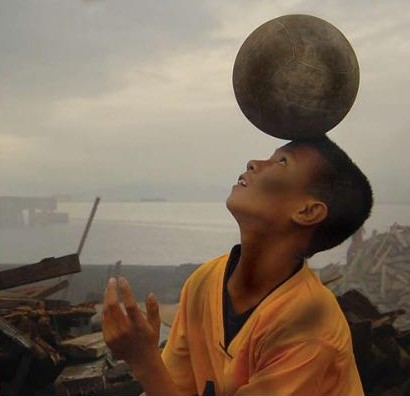“The stork in the heavens knoweth her appointed time; and the turtledove, and the crane, and the swallow, observe the time of their coming.” — Jeremiah (8:7)
Last weekend, I saw 2011’s first set of southern hemisphere-bound migratory birds. It looked like a flock of geese and the grace at which the birds cut through the horizon was spectacular. The sight is one of the benefits of people like me, who frequent places that are along the route of these migrant flyers.

Birds follow a regular migration schedules. They fly south from late September to December, during the season of the Amihan (the northeasterly winds). They head back north from March to May, during the season we call the Tag-init. Understandably, they fly towards the warmer regions during the cold winter of the north and came back to their breeding grounds during spring-time. They do make brief stopovers in certain fishing grounds and swamplands in the Philippines, but do not stay for long in these places.
One can almost be certain whether a flock of birds is about to make a stop-over or is still set to fly a longer distance. Those that are set to land on the swamps and stay a while to eat and rest will break from their flying formation, while those that will continue to fly away retains their distinctive V-formation like those of a group of fighter planes we see in the movies.
The V-shaped formation serves two important purposes:
One reason is that the V formation allows each bird in the flock an unobstructed field of vision. This allows flock members to see each other and communicate while in flight. I am sure that the fighter pilots have learned this technique from a study of the birds’ flight patterns.
The other reason is that the V-formation conserves their energy. Each bird flies slightly above the bird in front of him, resulting in a reduction of wind resistance. The birds that follow the leader have an easier flight. The leader breaks the wind resistance, and the birds following can fly more efficiently. Without the V formation, most migratory birds will never have enough energy to make it to the end of their long migration.
But are the birds following the same leader all the time during the migration?
The answer is no. It is not the same bird that leads the formation. Every few minutes, one of the birds from the back of the flock will break away, fly to the front, and take over, giving the previous leader a chance to move back and take a break.
Is there something that humans can learn from the migratory birds?
A lot of things have been written about what humans can learn from the behavior of the birds. One of those I particularly liked is that of Tanveer Naseer a business coach and writer who wrote about it in one of his blog posts; (http://www.tanveernaseer.com/migrating-geese-a-lesson-in-leadership-and-collaboration/). I quote verbatim below that part of his article that refers to the lessons we humans can learn from the migratory birds (which in his case are the Canadian geese).
1. Leadership is about helping others, not just yourself
When the Canada geese travel in V-formation, the lead bird’s job is not simply to guide the other birds as to which direction to fly. Rather, the lead bird’s primary role is to help reduce air drag so that the flock can fly for greater distances without expending more energy.
The same approach applies to the role of leadership, where the function is not to get others to simply do your bidding, but doing whatever is in your abilities to help others succeed in reaching the shared goal.
2. Everyone has the ability to lead
There was a recent survey I read about where the majority of respondents related leadership to a title; that to be a leader in an organization, one had to be a CEO, director, manager, etc. Now if we look at how the geese designate who will take the front position, we see that each bird is given a turn in leading the formation. For the geese, it’s not a question of their position in the pecking order. Instead, it’s a matter of which bird has the ability in that moment to offer the support needed by the rest of the flock for them to reach their destination.
In looking at the behavior of how geese migrate, we can appreciate that leadership is not a position; it’s a disposition that people can exhibit regardless of whatever formal title they might carry in their organization.
3. You can accomplish more working together than working apart
Scientists have found that when geese fly together in the V-formation, they can cover 70% more distance than if the birds were to fly alone. Given the long distances geese have to travel in the spring and fall, it’s clearly advantageous for them to work in a collaborative fashion, with each of them taking turns to reduce air drag while the others rest.
While some in management positions might prefer to focus on maintaining the leverage they have over their employees, the reality is that their business won’t go very far unless they work together with their team and foster an understanding that there’s a shared goal between the company and its employees. As with the geese, pooling the strengths and abilities of a company’s workforce will allow businesses to cover more ground than if they were to leave internal silos in place.
4. Working together means having each other’s back
If you’ve seen the Canada geese flying in V-formation, you’re probably familiar with the fact that it’s hardly a static formation, like what you’d see with fighter jets at an air show. Instead, it’s constantly shifting and changing. This is a result of the fact that the birds in the flock are taking turns flying in the lead position in order to give the other birds a chance to rest near the back of the line. This also ensures that the flock evenly distributes the workload so that they can easily make the long journey to their target destination.”
Similarly, when leading a team or group of employees, it’s important that there’s an understanding that everyone on the team has each other’s back and that the workload will be shared to make sure that no one wears out before the team can reach their objective.
For the Canada geese, the act of flying in V-formation has certainly been vital to their ability to migrate over vast distances as the seasons change. As with so many other examples in nature, this behavior can also serve as a valuable reminder for businesses on how to approach leadership and team collaboration.
So, aside from the four lessons discussed above, what do you think are the other things we could learn from the migratory birds? Share them to us in the comments.




1,433 comments
Is the photo of the V of geese yours? (You snapped the image). If so, I was wondering if I could use it on my blog to accompany a poem that speaks of a V of geese.
If you purchased it, I can do the same. Thank you.
Sue Martin
Dear Sue,
The photo is not mine. A friend sent this to me via email. I was also looking for a nice image to accompany the blog, and he sent me one.
Nic